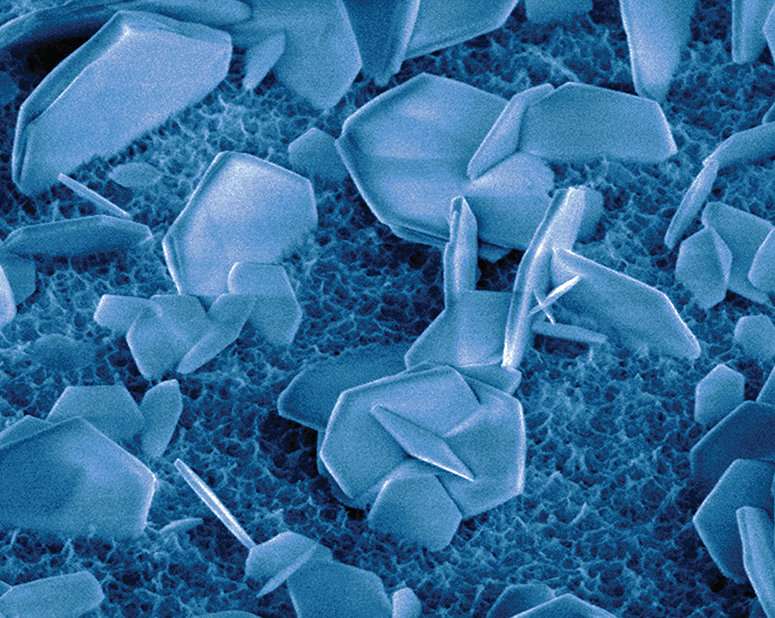Zinc oxide nanoparticles suspended in water snap together when properly aligned and form larger crystals (shown here). The forces between the particles along a specific attachment direction were measured by atomic force microscopy and computed by molecular dynamics simulations. Credit: US Department of Energy
Large crystals growing in water often form from tiny nanocrystals continually attaching together. During attachment, these tiny particles snap to the surface, like LEGO bricks. A bit of torque is needed to rotate the particles into position for attachment. By measuring and calculating the forces that provide this torque, researchers found that water has a more significant role than previously thought. Water templates on particle surfaces, organizing into structures that reach out to incoming particles, telling them how to optimally align themselves for attachment, to assemble into larger crystals. As these oriented particles are brought closer, the intervening water structures dissemble, allowing the particles to dock together.
Why study particle attachment? Understanding it enables more accurate predictions of when minerals will form and when they won't. This knowledge helps geoscientists with energy resource extraction and waste disposal. It's also crucial in the design of nanopatterned materials. The materials are used in electronic devices, catalyst supports, and energy storage. In these areas, aqueous-based manufacturing processes can benefit. They become more efficient and sustainable than traditional ones.
Knowing how minerals form is vital for subsurface energy extraction and waste storage, creating tailored catalysts, and more. Minerals can form via particle attachment, which involves amassing particles repeatedly until large crystals emerge, but researchers are still discovering when and how this occurs. During each step, a nano-sized particle snaps to the surface. As the particles attach, they expel water between their surfaces. The forces involved in this process had not been definitively determined. The team measured and calculated the forces that provide the torque for alignment, working at the near atomic scale. In a zinc oxide system, they found that water organizes on the particle surfaces. The water transmits structural data about the underlying surface to incoming particles. If incoming particles are strongly misaligned, water acts as a barrier to incorrect attachment, limiting the growth of defective crystals. Understanding water's many roles in mineral formation offers benefits in geosciences and aqueous-based materials design.
More information: X. Zhang et al. Direction-specific interaction forces underlying zinc oxide crystal growth by oriented attachment, Nature Communications (2017). DOI: 10.1038/s41467-017-00844-6
Journal information: Nature Communications
Provided by US Department of Energy
























